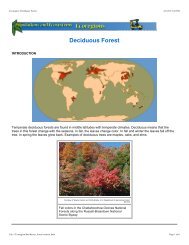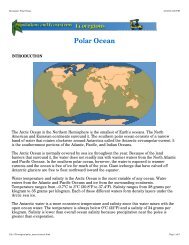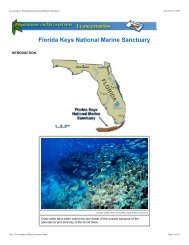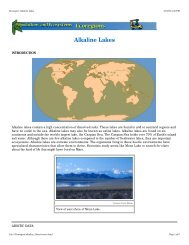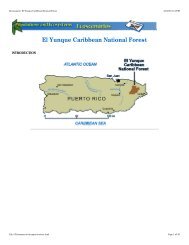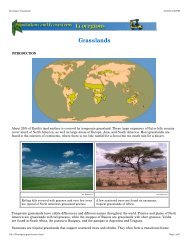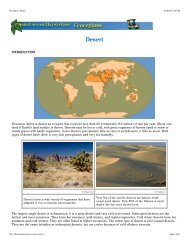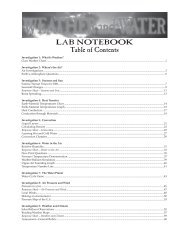Ecoscenarios Combined - FOSSweb
Ecoscenarios Combined - FOSSweb
Ecoscenarios Combined - FOSSweb
Create successful ePaper yourself
Turn your PDF publications into a flip-book with our unique Google optimized e-Paper software.
Ecoscenario: Cimarron National Grasslands<br />
4/16/03 3:09 PM<br />
Hot summers and cold winters are typical for Cimarron National Grassland.<br />
Grass fires are an essential part of grassland ecosystems. Fire quickly breaks down organic material and returns<br />
minerals to the soil. Fires start naturally from lightning strikes. They quickly burn through dead grass and forbs and<br />
are spread by high prairie winds. Native Americans understood the importance of grass fires and often set them.<br />
They used them to clear lands and drive bison herds to areas where they were easier to kill. Until homesteaders<br />
actively fought the fires to protect buildings and crops, grass fires annually swept across the prairie.<br />
BIOTIC DATA<br />
Cimarron National Grassland is a shortgrass prairie grassland. The landscape is dominated by wide expanses of<br />
grass-covered prairie. Some of the dominant grasses are blue grama, side-oats grama, and buffalo grass. Side-oats<br />
grama is the tallest, growing 0.3–1 meters (1–3.5 feet) tall. It makes excellent nesting material for birds and small<br />
rodents and the seeds and leaves are good forage. Blue grama is a little bit shorter, growing 0.3–0.6 meters (1–2<br />
feet) tall. It is also good forage and nesting material. Buffalo grass is shortest, only 10–30 centimeters (4–12<br />
inches) tall. It spreads across the ground with creeping runners called stolons. While buffalo grass is a poor forage<br />
and nesting material for birds and small mammals, it is important food for pronghorn antelope, bison, cattle, and<br />
other grazing animals. The root systems of prairie grasses grow deeply into the soil. The deep roots survive fires<br />
that destroy the exposed top.<br />
Other range plants found growing among the grass at Cimarron are western ragweed, common sunflower,<br />
prickly<br />
pear cactus, sagebrush, and western buckwheat. A few trees dot the landscape, such as the cottonwood tree,<br />
Osage orange, and eastern red cedar. Trees are usually found growing along stream banks, near water wells, or<br />
near ponds. Most sapling trees in the open grassland burn before they can grow large enough to withstand a grass<br />
fire.<br />
file:///Ecoscenario/cimarron/content.html<br />
Page 4 of 12



